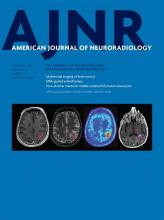Index by author
Fakhran, S.
- ADULT BRAINYou have accessPrincipal Component Analysis of Diffusion Tensor Images to Determine White Matter Injury Patterns Underlying Postconcussive HeadacheA. Ghodadra, L. Alhilali and S. FakhranAmerican Journal of Neuroradiology February 2016, 37 (2) 274-278; DOI: https://doi.org/10.3174/ajnr.A4505
Fesl, G.
- NeurointerventionYou have accessStent Retriever Thrombectomy in Patients Who Are Ineligible for Intravenous Thrombolysis: A Multicenter Retrospective Observational StudyF. Dorn, S. Prothmann, M. Patzig, H. Lockau, C. Kabbasch, O. Nikoubashman, T. Liebig, C. Zimmer, H. Brückmann, M. Wiesmann, H. Stetefeld, H. Poppert, A. Reich, L. Kellert and G. FeslAmerican Journal of Neuroradiology February 2016, 37 (2) 305-310; DOI: https://doi.org/10.3174/ajnr.A4520
Forman, H.P.
- EXTRACRANIAL VASCULARYou have accessEvaluation for Blunt Cerebrovascular Injury: Review of the Literature and a Cost-Effectiveness AnalysisA. Malhotra, X. Wu, V.B. Kalra, J. Schindler, C.C. Matouk and H.P. FormanAmerican Journal of Neuroradiology February 2016, 37 (2) 330-335; DOI: https://doi.org/10.3174/ajnr.A4515
Fox, A.J.
- FELLOWS' JOURNAL CLUBEXTRACRANIAL VASCULAROpen AccessCarotid Near-Occlusion: A Comprehensive Review, Part 2—Prognosis and Treatment, Pathophysiology, Confusions, and Areas for ImprovementE. Johansson and A.J. FoxAmerican Journal of Neuroradiology February 2016, 37 (2) 200-204; DOI: https://doi.org/10.3174/ajnr.A4429
Carotid near-occlusion is distal luminal collapse of the internal carotid artery beyond a tight stenosis. Part 2 of this systematic review focuses on prognosis and treatment and pathophysiology. Areas of confusion regarding terminology, diagnosis, and prognosis are also covered.
Fujima, N.
- EDITOR'S CHOICEHead and Neck ImagingOpen AccessUsefulness of Pseudocontinuous Arterial Spin-Labeling for the Assessment of Patients with Head and Neck Squamous Cell Carcinoma by Measuring Tumor Blood Flow in the Pretreatment and Early Treatment PeriodN. Fujima, D. Yoshida, T. Sakashita, A. Homma, A. Tsukahara, K.K. Tha, K. Kudo and H. ShiratoAmerican Journal of Neuroradiology February 2016, 37 (2) 342-348; DOI: https://doi.org/10.3174/ajnr.A4513
Forty-one patients with head and neck squamous cell carcinoma were evaluated by using pseudocontinuous ASL. Quantitative tumor blood flow was calculated at the pretreatment and the early treatment periods. Pretreatment tumor blood flow in patients in the treatment failure group was significantly lower than that in patients in the local control group. The use of the percentage change of tumor blood flow combined with the percentage change of tumor volume had high diagnostic accuracy for predicting local control.








